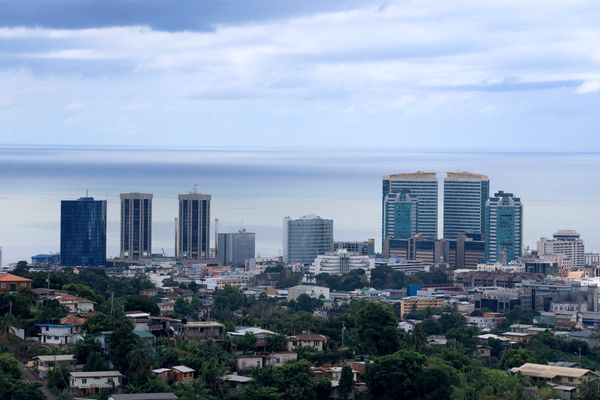

The recent Sunny Dé x Supré event, which celebrated a new collaboration between 14-year-old Australian influencer Deja Clark and teen fast fashion brand Supré, has reignited a conversation about diversity, or the lack thereof, in Australia’s influencer scene.
Deja, daughter of lifestyle influencer Kat Clark, launched her Sunny Dé brand last week with Supré.
Kat Clark, who boasts a following of 9 million on TikTok alone, has openly spoken about her Filipino heritage and the bullying her daughter faces as a Black and Filipino content creator.
TikTok videos from her daughter’s event sparked a conversation about the lack of diversity in race and size.
Kat Clark addressed the criticism in a TikTok, recounting the bullying Deja experienced growing up as the only Black girl at school, and the importance of celebrating the achievement of a young Black female-owned business. Clark also stated her daughter chose a Black model because representation is important to her.
Most of the criticism was not directed at the 14-year-old, but rather the adults on her team, and at Kat’s comments in the TikTok that the lack of diversity was due to Deja growing up with mostly white friends, that only 1.3 per cent of Australia was Black and that they “didn’t invite people based off their skin colour”.


Black Australian creator Kristine Achayo responded with a TikTok stressing how important — and easy — it is to make events more inclusive.
In a follow-up TikTok, speaking from her own experience, Achayo says, “from wrong shade matches from PR to being exploited as the only Black girl at events… please do better”.
Meanwhile, Bangladeshi Australian influencer Sophia spoke about her experience previously working in the Supré PR and marketing team, saying it should not be the creators but “the brands, the PR agencies who should be doing the work” to ensure diversity, “especially when brands are POC led”.
Sophia pointed out that Fenty and Huda Beauty, brands owned by women of colour, made an effort to platform women of colour as well.
Why diversity matters
It goes without saying that this is not the first time diversity has been an issue in the Australian media and entertainment space. At Fashion Week earlier this year, many called for more diverse representation and noted the decreasing representation over the years.
Influencer marketing expert Sarah Evans says brands usually rely on algorithms that favour established influencers, typically white, thin and able bodied, rather than prioritising diversity in their search for influencers.
Studies have found that algorithmic bias on platforms like Instagram, X, and TikTok reflect societal beauty ideals that have historically marginalised certain groups based on race, ethnicity, body type, or other characteristics.
This means that creators who do not meet the beauty standard, whether because of race, size, or ability, likely have fewer followers than their white, straight-sized, and able-bodied counterparts.
In 2022, an American report found that while 41 per cent of white influencers had over 50k followers with an earning potential of USD$100,000 (AUD$152,643) in brand deals, only 23 per cent of Black influencers had over 50k followers.
A 2024 report from the UK-based SevenSix Agency showed that influencers of Southeast Asian descent earned an average of £700 (AUD$1,250) per sponsored Instagram video post, 57 per cent less than the average £1,638 (AUD$2,927) for white influencers.
South Asian, Black and East Asian influencers are also paid lower amounts generally, with average fees of £1,135 (AUD$2,028), £1,080 (AUD$1,929) and £1,010 (AUD$1,804), respectively.
Experts have been calling for the regulation of algorithmic bias. Still, until platforms take accountability, they note that brands and influencers need to do their part by promoting diversity where they can. Brand trips, marketing, and product manufacturing are perfect examples of where they can effect change.
As someone who often finds myself as the only person of colour in many spaces, whether that be work related or otherwise, I can say firsthand that it is extremely isolating. There are times when you will be invited to attend an event and not be paid, while your white and “more established” counterparts are compensated, or you’ll be invited as an afterthought when the organisers realise they have curated an all-white panel.
Which brings me to the question: When is it tokenism, and when is it diversity?
Tokenism is diversity without inclusion, while diversity requires meaningfully including various voices, perspectives, and experiences.
For me, genuine diversity feels like walking into a space where I’m valued for who I am, my values and what I bring to the table, not my skin colour. It means seeing other people who look like you instead of being typecast as “the Brown one”.
It’s important to remember that prioritising diversity is not just about fairness. Research shows that companies with more diverse teams are 35 per cent more likely to outperform their competitors, and almost 60 per cent of consumers are more loyal to and prefer to buy from brands that have diversity in their marketing.
Representation in these spaces is about more than a single event. It’s about ensuring young people see themselves reflected in the brands they love. And every action taken to promote diversity has an impact.
A 2024 study by the University of New South Wales found that viewing even a small number of body-positive social media posts, among the social media content young people regularly view, can improve body image and reduce body comparisons.
So, what can be done?
When the value of diversity is being questioned, as we are seeing with the March for Australia protests across the country, it is simply not good enough to say that diversity, whether that be race, size, sexuality, or ability, is not a consideration in a brand’s marketing strategy.
And while I agree that the burden of educating on and pushing for diversity shouldn’t fall on marginalised creators alone, it is important for those creators to use their platform to uplift, instead of perpetuating the cycle.
Several creators are doing exactly this. In a TikTok, Black Australian creator, Mulan, listed Australian POC brands and creatives to get around.
Here are some she listed alongside a few others we thought you should be across:
Influencers:
- Maia Onyenachi (@maiaonyenachi)
- Meissa Mason (@meissamason)
- Unice Wani (@unicewani)
- Sonali Fernando (@gnarlynandos)
- Tatenda Luna (@tatendaluna)
- Pol (@SmallPol)
- Grave Korovata (@gracekorovata)
- Tallulah (@tallulahsrash)
- Aretha Brown (@_enterthedragon_)
- Victoire Lokpo (@viiccckii)
- Angelica Patterson (@angelikurr)
- Maraika Rose (@maraika.rose)
- Sinit (@asinderellastory)
- Amber Akilla (@amberakilla)
- Natalie Loos (@natloos.jpg)
- Marissa Lepps (@marissalepps_)
- Melisa (@delishdump)
Brands:
- Jadire
- Mountain and Moon
- Discrexion
- RampTrampStam
- Haus of Dizzy
- Gammin Threads
- House of Darwin
- Clothing The Gaps
- Made U Look
- Kirrikin
The post Kat Clark’s Supré Controversy Highlights Why We Need Diversity In Influencer Spaces appeared first on PEDESTRIAN.TV .







